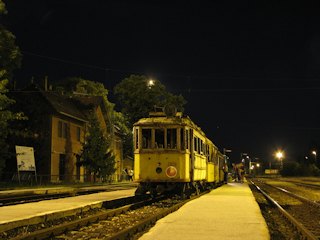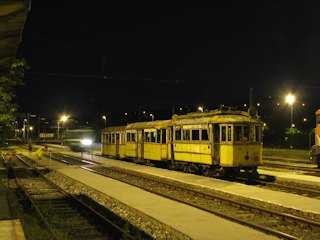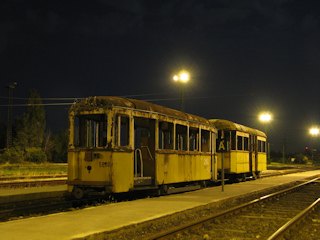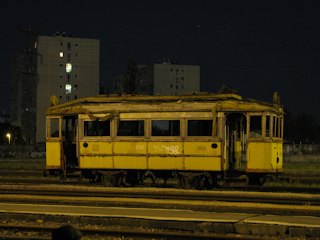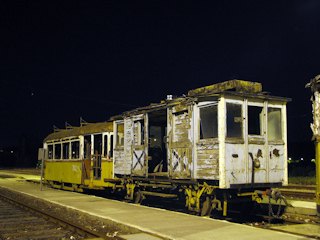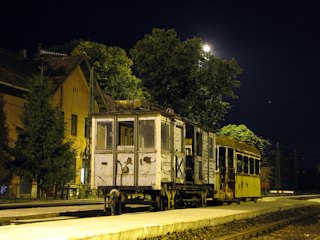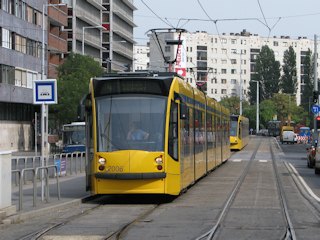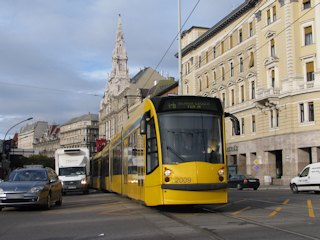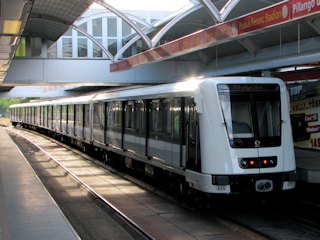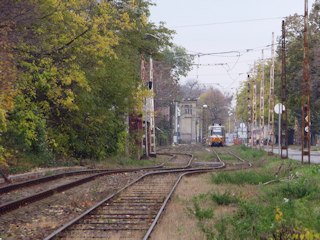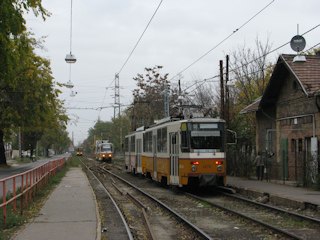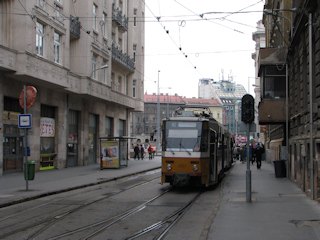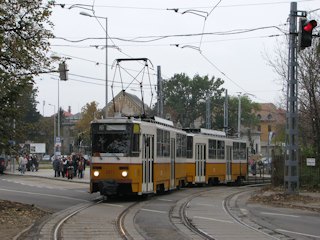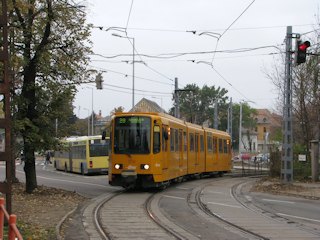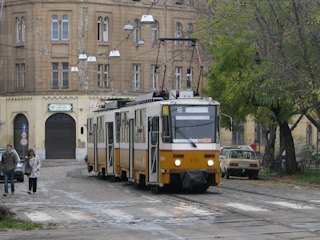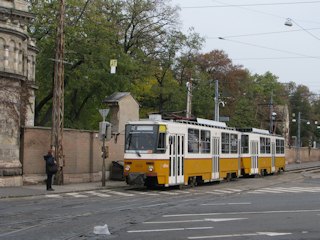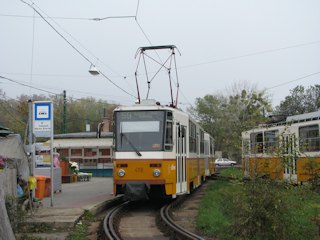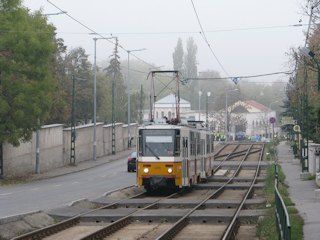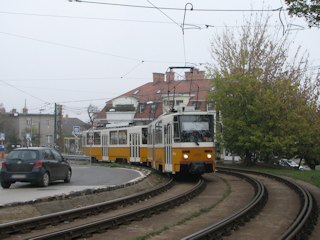Trams of Hungary and much more...
Spring to Winter 2012
An era of Budapest public transit ended - at last, if I may say so: the ZiU-9 trolley buses, introduced in 1975 were withdrawn from scheduled traffic in December 2012. Now, these vehicles looked like they're from a war-torn ex-Soviet republic, and they were not really a favorite of mine, but they probably deserve a mention here.
The oldest of the operational ZiU-9s was number 904, it celebrated its 34th anniversary in traffic on route 78 - but the others did also look quite worn. I don't think the passengers will miss them. Three of them will be retained for overhead de-icing and heritage operations, one will go to the Szentendre museum.
If you're wondering what these strange-looking vehicles sounded and felt like, here's a video of them dashing through the streets, winding in at corners, popping in the air on potholes, with the compressor roaring and the drive axle howling.
Back to trams and back to the summer: six historic vehicles were brought back to the city in July from the backyard of the HÉV depot in Szentendre, where they've been standing for decades under the sky.
The HÉV to Szentendre lacks a direct connection to the tram network since the mid-1990s, so the transport had to be done over state railway tracks. Until a few years ago this was a simple deal: BKV was allowed to use these tracks with its own diesel locomotives, but nowadays they have to rent a locomotive, pay for track usage and personnel, making the whole deal cumbersome. On top of this, the old vehicles were first denied running permits, so it looked they were to stay out in Szentendre. Fortunately then another rail operator was able to get the necessary permits.
On these pictures: EP class trailer number 5800 from 1939, OP class trailer 5600 from 1930, and number 2806 from 1911.
From Szentendre the tow was brought to Aquincum elágazás by an L.VII-class electric locomotive of the HÉV (to the left). From there the old cars were pushed up to Óbuda station via the unelectrified connecting track by a small HÉV railcoach, visible to the left on the picture to the right. From there a class M44 diesel-electric locomotive of private rail operator MMV (to the right) took over. It towed one old tram at a time over to Angyalföld station, where the Unimog of the BKV took over, and lowered them one by one into the Angyalföld tram depot.
Each movement involved lots of shunting around.
During the next night three more oldtimers were transported: number 1914 from 1907...
... shunter number M4 from Miskolc, built in 1907, and EP trailer number 5884. Note that although this trailer is a kin to number 5800 transported previously, it's in a quite different get-up: on one hand it was built ten years later, on the other it sports open platforms and other, more old-style features.
Since then these vehicles were transported from the Angyalföld tram depot to the Zugló tram depot.
To the left: things started to get back to normal on route 4 after a traffic disruption, but the Újbuda-központ terminus (formerly known as Fehérvári út or Bocskai út) was unable to cope with the sudden influx of Combinos right away. To the right: normal traffic flow at Blaha Lujza tér.
Various public transit
scenes from Budapest, from suburban railway to buses, from trams to trolley
buses and trains:
0:03- Outbound HÉV train on the Szentendre line at Csillaghegy
0:17- Ikarus 415 rolling downwards in Szilágyi
Erzsébet fasor, with the tracks of tram 61 to the left
0:25- Tram 59 in Szilágyi Erzsébet
fasor near Széll Kálmán tér
0:37- Chime on top of an old school building
at the Gárdonyi
tér tram stop.
0:48- FLIRT double EMU unit of the state
railways arriving to Budatétény-Campona station
1:20- Combino on depot run at Orczy
tér (this is not on the normal route where these trams are operating)
1:42- Ganz artic leaving the backyard
of the Kelenföld tram depot
2:00- Ganz-Solaris trolley buses in Nagymező
utca, with the statue of composer Imre Kálmán in the foreground
2:09- ZiU-9 trolley buses of route 74/74A
crosses Rákos-patak
2:17- Ikarus 411T trolley bus (a one-off
vehicle) arriving to Báthory utca
2:26- Tram 61 reversing at Budaörsi út during a traffic disruption
2:24- Ex-Brussels VanHool articulated
bus in Kozma utca, next to the terminus of tram 28
2:56- Ex-Hannover TW6000 in Népszínház
utca
3:08- Tram 19 in the Christmasly decorated Bartók Béla út
The first Alstom "Metropolis" trains of metro line M2 entered traffic on September 7, 2012. This was an important date in a row of unpleasant events like denied technical permits, the BKV quitting the contract, Alstom suing back, negotiations, then modifications and new trial runs. Just as an information: the first two cars of a five-car train have arrived on January 27, 2009: three and a half years before entering traffic!
Although I'm not a fan of metros, I went out on the big day to see and try the new train. This day also marks the start of the withdrawal of the old Soviet trains - by Summer 2015 the M2 line should be serviced only by Alstoms.
I also tried to make a video, although that's not easy in a working day afternoon crowd :)
The extra traffic around All Souls' Day always results in interesting tram services and/or changes in the rolling stock used on some lines, and this year was no exception: because tram line 37, the direct way to the New Public Cemetery ("new" only in the name - it was opened in 1886) was blocked due to the renovation of a railway flyover, route 28 had had to supplement that, too.
The most visible change was that route 28 - and its off-peak counterpart 28A - was operated with ex-Hannover TW6000 trams instead of Tatras, as seen to the left. On that picture we see car number 1581 waiting for departure at the Israelite cemetery, the outer one of the two tram termini located just a stop away from each other in Kozma utca. You can see that this place used to have more tracks than it has now. The picture to the right shows the other terminus, Új Köztemető (Kozma utca) with a Tatra T5C5 double-set of the special line 28B. This line was special in that it was running to Keleti pályaudvar instead of Blaha Lujza tér. In the background you can also see another tram 28 waiting at the Israelite cemetery.
The stretch between the two termini looks very stupid without the third track.
To the left we see a strange relict of times long passed: today's line 37 was originally built as a steam tramway in 1891, thus today's terminus was more of a railway station than a tram stop. The station building is still standing, although it's not used by the BKV anymore (the water tower for the steam locomotives is also long gone). To the right: 28B at Keleti pályaudvar.
More pictures of the somewhat austere neighbourhoods around the "old new" cemetary, taken amongst austere weather and lighting conditions. The fortress-like building in the background is not the cemetery, but the Budapest Central Prison.
A few minutes of the same vicinities, on video.
I already mentioned that route 37 was shortened due to the renovation of a flyover, so it only ran between Blaha Lujza tér and Kőbányai garázs. Here are two photos of that short service called 37A on the two sides of the crossing Fiumei út/Salgótarjáni utca.
Route 59 is the other tram line in Budapest that was built because of a cemetery in 1902, although it runs through more upper-class neighbourhoods than tram 28 and 37, and has a fair share of traffic all year, not just during these days. To the left: the terminus at Márton Áron tér. A nice place, rumoured to be soon converted into a simple stub terminus (probably with a scissors crossover). I don't know if that'll really happen, they have been speaking about this for years, yet the Tatras are still screeching through in the tight loop. To the right: this tram just reached the plateau on which the terminus is located, the climbing is over :)
Tatra T5C5K double-set using the reversing loop at Márton Áron tér - quite loudly.
To the left: Németvölgyi út, with the main entrance of the Farkasrét cemetery in the background. This was where the line originally ended, until it was extended to the current terminus in 1913. The crossover in the back is very rarely used. To the right: the bend at Érdi út.


